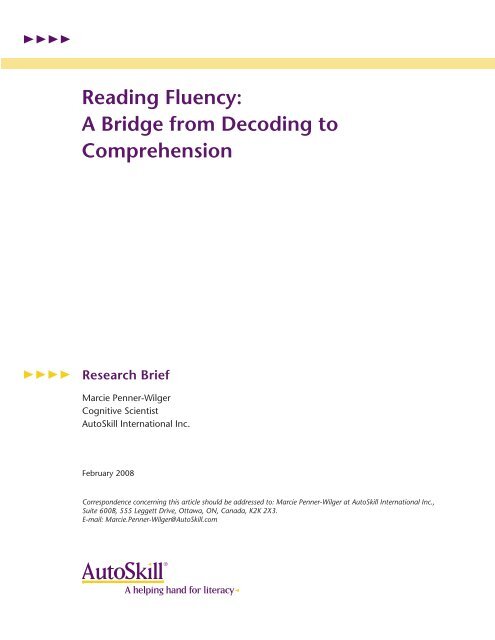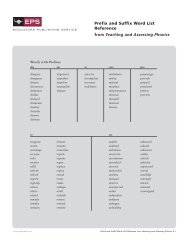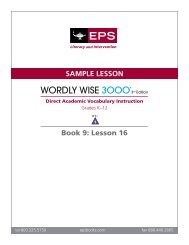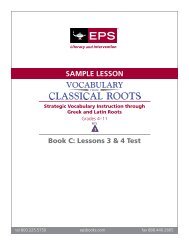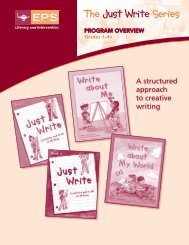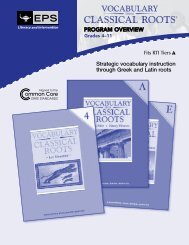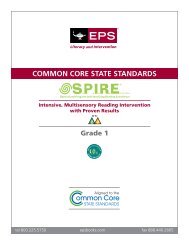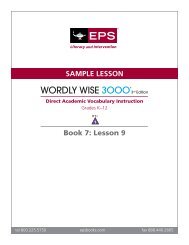Reading Fluency: A Bridge from Decoding to Comprehension
Reading Fluency: A Bridge from Decoding to Comprehension
Reading Fluency: A Bridge from Decoding to Comprehension
Create successful ePaper yourself
Turn your PDF publications into a flip-book with our unique Google optimized e-Paper software.
<strong>Reading</strong> <strong>Fluency</strong>:<br />
A <strong>Bridge</strong> <strong>from</strong> <strong>Decoding</strong> <strong>to</strong><br />
<strong>Comprehension</strong><br />
Research Brief<br />
Marcie Penner-Wilger<br />
Cognitive Scientist<br />
Au<strong>to</strong>Skill International Inc.<br />
February 2008<br />
Correspondence concerning this article should be addressed <strong>to</strong>: Marcie Penner-Wilger at Au<strong>to</strong>Skill International Inc.,<br />
Suite 600B, 555 Leggett Drive, Ottawa, ON, Canada, K2K 2X3.<br />
E-mail: Marcie.Penner-Wilger@Au<strong>to</strong>Skill.com
<strong>Reading</strong> <strong>Fluency</strong>: A <strong>Bridge</strong> <strong>from</strong> <strong>Decoding</strong> <strong>to</strong> <strong>Comprehension</strong><br />
Abstract<br />
<strong>Reading</strong> fluency forms a bridge <strong>from</strong> decoding <strong>to</strong> comprehension (Rasinski, 2004). The purpose of this<br />
paper is <strong>to</strong> provide a practical review of research, theory, and instructional practice related <strong>to</strong> reading fluency.<br />
In this review paper, reading fluency is defined, along with a discussion of the necessary component<br />
skills. Research on the importance of fluency <strong>to</strong> reading outcomes, including performance on state tests,<br />
is summarized. Practical information on fluency assessment, instructional approaches shown <strong>to</strong> improve<br />
fluency, and interventions for students with poor reading fluency, is included in this review.<br />
<strong>Reading</strong> <strong>Fluency</strong>: A <strong>Bridge</strong> <strong>from</strong> <strong>Decoding</strong> <strong>to</strong> <strong>Comprehension</strong><br />
What is <strong>Reading</strong> <strong>Fluency</strong>?<br />
What does it mean <strong>to</strong> be a fluent reader? When reading aloud, fluent readers sound natural. Their reading<br />
is accurate, quick, and uses proper expression. In contrast, dysfluent readers may make many errors, their<br />
reading may be slow and laborious as they employ strategies <strong>to</strong> identify words, and their reading may lack<br />
expression, instead being mono<strong>to</strong>ne and unnatural sounding. Based on these observable differences, fluency<br />
of oral reading can be easily assessed within 60 seconds (Rasinski, 2004). Though most easily assessed orally,<br />
reading fluency is not solely an oral skill. <strong>Reading</strong> fluency is defined as the ability <strong>to</strong> decode and comprehend text<br />
at the same time (NICHD, 2000; Samuels, 2006). This definition of reading fluency has been expanded <strong>from</strong><br />
earlier conceptualizations, which focused only on word recognition (Harris & Hodges, 1995) and those that<br />
focused solely on the components or indica<strong>to</strong>rs of fluency without attention <strong>to</strong> the larger concept of fluency.<br />
Components/Foundational Skills of <strong>Reading</strong> <strong>Fluency</strong><br />
<strong>Reading</strong> fluency is comprised of three component skills, or fluency indica<strong>to</strong>rs:<br />
Au<strong>to</strong>Skill International Inc.<br />
• accuracy of word decoding,<br />
• au<strong>to</strong>maticity of word recognition, and<br />
• prosody of oral text reading<br />
Accuracy of decoding refers <strong>to</strong> the ability <strong>to</strong> correctly generate a phonological representation of each word,<br />
either because it is part of the reader’s sight-word vocabulary or by use of a more effortful decoding strategy<br />
such as sounding out the word. Skills required for accuracy of decoding include: alphabetic principles, the<br />
ability <strong>to</strong> blend sounds, the ability <strong>to</strong> use cues <strong>to</strong> identify words in text, and a large sight-word vocabulary<br />
of high-frequency words (Torgesen & Hudson, 2006). Accurate decoding is a requirement for building the<br />
next component of reading fluency – au<strong>to</strong>maticity.<br />
Au<strong>to</strong>maticity of word recognition refers <strong>to</strong> the ability <strong>to</strong> quickly recognize words au<strong>to</strong>matically, with little<br />
cognitive effort or attention. Au<strong>to</strong>maticity is gained through practice <strong>to</strong> the point where previously effortful<br />
tasks, such word decoding, become fast and effortless – freeing up cognitive resources for other tasks, such<br />
2
Au<strong>to</strong>Skill International Inc.<br />
<strong>Reading</strong> <strong>Fluency</strong>: A <strong>Bridge</strong> <strong>from</strong> <strong>Decoding</strong> <strong>to</strong> <strong>Comprehension</strong><br />
as text comprehension. Au<strong>to</strong>maticity requires quick and accurate identification of individual words as well<br />
as speed and fluidity in reading connected text (Torgesen & Hudson, 2006). Au<strong>to</strong>maticity is a requirement<br />
for building the next component of reading fluency – prosody – as the au<strong>to</strong>matic decoding of words frees<br />
up attentional resources required for prosody.<br />
Prosody of oral text reading refers <strong>to</strong> naturalness of reading, or the ability <strong>to</strong> read with proper phrasing<br />
and expression, imbuing text with suitable volume, stress, pitch and in<strong>to</strong>nation. Prosody is an indica<strong>to</strong>r<br />
that the reader is actively constructing the meaning of a passage as they read (Torgesen & Hudson, 2006).<br />
Indeed, prosody may both serve as an indica<strong>to</strong>r that a student is comprehending as they read and also aid<br />
comprehension (Rasinski, 2004).<br />
<strong>Reading</strong> fluency is situational (Samuels, 2006; Topping, 2006). For example, though your reading of this<br />
article is fluent, the reading of some academic articles is likely <strong>to</strong> be fluent only for those with specific<br />
subject-matter expertise. Sources of variability in fluency within an individual include: readability level of<br />
the text (proportion of words that can be recognized au<strong>to</strong>matically, by sight), the student’s familiarity with<br />
the <strong>to</strong>pic (sight-word vocabulary and ability <strong>to</strong> use context <strong>to</strong> aid word identification), and the priority the<br />
student gives <strong>to</strong> speed versus accuracy in the specific situation (Topping, 2006).<br />
Sources of variability in fluency across students include: the size of a student’s sight-word vocabulary,<br />
individual variations in processing speed of word recognition, speed of decoding processes for unknown<br />
words, ability <strong>to</strong> use context <strong>to</strong> aid word identification, ability and speed with which word meanings are<br />
retrieved, ability and speed with which overall meaning is constructed, and a student’s relative priority of<br />
speed versus accuracy (Topping, 2006). Of the sources of variability across students, sight-word reading<br />
efficiency, a measure of both the size of readers’ sight-word vocabulary and the speed with which individual<br />
words could be recognized, has the strongest relation with reading fluency for children in Grades 2 – 7<br />
(rs .71-.89; Torgesen, Rashotte, & Alexander, 2001).<br />
The Au<strong>to</strong>maticity Theory of <strong>Reading</strong> <strong>Fluency</strong><br />
LaBerge and Samuels (1974) developed the Au<strong>to</strong>maticity Theory of reading. Au<strong>to</strong>maticity is the ability <strong>to</strong><br />
perform a complex task quickly, with few attentional resources. The Au<strong>to</strong>maticity Theory of reading draws<br />
on a wealth of cognitive research showing that the brain has limited attentional capacity, and the ability <strong>to</strong><br />
perform two complex tasks simultaneously requires at least one <strong>to</strong> have become au<strong>to</strong>matic. Au<strong>to</strong>maticity<br />
develops as the result of extended practice, wherein a complex task that once was slow and required a great<br />
deal of attentional resources gradually becomes au<strong>to</strong>matic.<br />
LaBerge and Samuels (1974) applied the concept of au<strong>to</strong>maticity <strong>to</strong> the reading process. Fluent readers are<br />
able <strong>to</strong> simultaneously decode and comprehend text. Given that both decoding and comprehension are<br />
difficult tasks, at least one task must be au<strong>to</strong>matic in fluent readers. In beginning and struggling readers, the<br />
task of decoding uses most if not all attentional resources, allowing few resources for comprehension. Through<br />
extensive practice, readers become au<strong>to</strong>matic decoders, able <strong>to</strong> quickly recognize a large lexicon of words.<br />
When decoding is au<strong>to</strong>matic, attentional resources are available for comprehension, and metacognition<br />
3
<strong>Reading</strong> <strong>Fluency</strong>: A <strong>Bridge</strong> <strong>from</strong> <strong>Decoding</strong> <strong>to</strong> <strong>Comprehension</strong><br />
(active moni<strong>to</strong>ring and regulation of one’s own reading). <strong>Decoding</strong> has a reciprocal relation with<br />
comprehension; when reading in an area of expertise, comprehension can aid decoding.<br />
To become au<strong>to</strong>matic decoders, able <strong>to</strong> au<strong>to</strong>matically generate a phonological representation of each word,<br />
readers must learn the distinctive features of letters and then of words. With practice, letters and then<br />
words become unitized -- seen as a holistic unit rather than a collection of features. Fluent readers have<br />
unitized high frequency words. Thus, <strong>to</strong> develop fluency readers require letter familiarity, phonemic awareness,<br />
and phonics, along with a vocabulary of high frequency words, knowledge of word parts and spelling<br />
patterns (rimes and phonographs), decoding strategies, and oral language skills (Ehri, 1995, 1998).<br />
Importance of <strong>Reading</strong> <strong>Fluency</strong><br />
On the basis of scientifically-based research (for reviews see: Chard, Vaugh, & Tyler, 2002; Kuhn & Stahl,<br />
2000; NICHD, 2000), No Child Left Behind, <strong>Reading</strong> First, and the National <strong>Reading</strong> Panel have all<br />
identified fluency as a critical component of an effective reading program (NCLB, 2001, NICHD, 2000). In a<br />
large study of a representative sample of fourth grade students, however, 44% could not fluently read gradeappropriate<br />
text (Pinnell et al., 1995). One in five students who failed a fourth-grade state reading test were<br />
au<strong>to</strong>matic decoders yet had poor comprehension skills (Buly & Valencia, 2002). Moreover, students referred<br />
for supplementary reading instruction were most likely <strong>to</strong> show difficulty in fluency, compared <strong>to</strong> decoding<br />
or comprehension (Rasinski & Padak, 1998).<br />
A key reason that fluency is viewed as a critical component of reading programs is that fluency is associated<br />
with reading outcomes, including comprehension. Pinnell et al. (1995) found that fluency was significantly<br />
associated with reading proficiency; more fluent readers scored higher on the NAEP reading assessment.<br />
Fuchs, Fuchs, and Maxwell (1998) also found a strong relation between fluency and comprehension<br />
(r = .91). Alling<strong>to</strong>n (1983) increased awareness of the importance of fluency in proficient reading, concluding<br />
that fluency instruction shows great promise for improving the performance of struggling readers.<br />
<strong>Reading</strong> fluency is correlated with reading outcomes on state tests. Stage and Jacobsen (2001) found that<br />
fluency scores were correlated with fourth-grade reading scores on the Washing<strong>to</strong>n Assessment of Student<br />
Learning (WASL). McGlinchey and Hixon (2004) found that fluency scores were correlated with fourthgrade<br />
reading scores on the Michigan Educational Assessment Program (MEAP). In a large longitudinal<br />
study of students in Grades 3, 5 ,7 and 8, Silberglitt et al. (2006) found that fluency scores significantly<br />
predicted performance on the Minnesota Comprehensive Assessments – <strong>Reading</strong> (MCA-R; rs .50-.68).<br />
<strong>Fluency</strong> was the dominant fac<strong>to</strong>r accounting for individual differences in reading comprehension on the<br />
FCAT, accounting for 56 % of variance in third-grade reading scores and remaining dominant in seventh<br />
grade. Thus, reading fluency robustly predicts performance on state reading tests across grades and states.<br />
Au<strong>to</strong>Skill International Inc.<br />
4
How <strong>to</strong> Assess <strong>Reading</strong> <strong>Fluency</strong><br />
Au<strong>to</strong>Skill International Inc.<br />
<strong>Reading</strong> <strong>Fluency</strong>: A <strong>Bridge</strong> <strong>from</strong> <strong>Decoding</strong> <strong>to</strong> <strong>Comprehension</strong><br />
Both the National <strong>Reading</strong> Panel (NICHD, 2000) and the National Research Council (Snow, Burns, & Griffin,<br />
1998) recommend that teachers assess fluency regularly (NICHD, 2000). <strong>Fluency</strong> assessments need <strong>to</strong><br />
cover the three component skills or indica<strong>to</strong>rs <strong>to</strong> provide a valid measure of fluency: accuracy of decoding,<br />
au<strong>to</strong>maticity/rate of word recognition, and prosody of oral text reading. Rasinski (2004) outlines a quick<br />
assessment method that is easily administered and has been shown <strong>to</strong> be both reliable and valid: Curriculum-Based<br />
Measurement (CBM; Deno, 1985) also called Oral <strong>Reading</strong> <strong>Fluency</strong> (ORF). In CBM, the teacher<br />
listens <strong>to</strong> and/or tape-records the student reading a grade-level passage for one minute. The <strong>to</strong>tal number<br />
of words read, the number of uncorrected errors, and the number of words read correctly (WCPM) are<br />
recorded. Rasinski (2004) adapted CBM, such that all three component skills can be assessed <strong>from</strong> this<br />
one-minute recording and compared against target norms, provided by grade and time of testing.<br />
• Accuracy, or percentage of words read correctly, is calculated as words correct divided by the <strong>to</strong>tal<br />
number of words read (WCPM/<strong>to</strong>tal).<br />
• Rate is simply the number of words read correctly in one minute (WCPM).<br />
• Prosody is assessed using a qualitative rubric, two of which are provided: the NAEP four-point rubric<br />
and the Zutell and Rasinski (1991) multidimensional fluency rubric.<br />
Given the ease of administration and interpretation, these assessments can be repeated throughout the<br />
school year using different grade-level passages, meeting the recommendation for regular fluency assessment.<br />
Alternative fluency assessment <strong>to</strong>ols are available, including the Gray Oral <strong>Reading</strong> Test (Wiederholt &<br />
Bryant, 2003), a standardized test that assesses accuracy, rate, and comprehension. The Dynamic Indica<strong>to</strong>rs<br />
of Basic Early Literacy Skills (DIBELS; Good & Kaminsky, 2002) is a widely used test of fluency, yet is criticized<br />
for measuring only the speed component of fluency, providing a potentially misleading and invalid<br />
measure (Alling<strong>to</strong>n, 2006; Pressley, et al., 2005; Samuels, 2006).<br />
Instructional Approaches that Improve <strong>Reading</strong> <strong>Fluency</strong><br />
<strong>Reading</strong> fluency develops <strong>from</strong> practice. Rasinski (1989) provides a review of existing instructional<br />
approaches that have been shown <strong>to</strong> improve children’s reading fluency, including: modeling fluent<br />
reading, practiced/repeated reading, assisted reading (i.e., listening <strong>to</strong> a tape while reading), and focusing<br />
on phrasing while reading. Two major instructional approaches have been proposed <strong>to</strong> increase reading<br />
fluency: repeated oral reading practice (with guidance and/or feedback) and independent silent reading<br />
practice. In 2000, the National <strong>Reading</strong> Panel reviewed the existing scientific evidence on the effectiveness<br />
of each of these instructional approaches.<br />
Repeated Oral <strong>Reading</strong>. There is a wealth of evidence that repeated reading, in various forms, increases<br />
reading fluency. A meta-analysis (NICHD, 2000) showed that repeated oral reading practice has a significant<br />
positive effect on accuracy (d = .55), fluency (d = .44), and comprehension (d = .35). Samuels (1979) found<br />
5
<strong>Reading</strong> <strong>Fluency</strong>: A <strong>Bridge</strong> <strong>from</strong> <strong>Decoding</strong> <strong>to</strong> <strong>Comprehension</strong><br />
that repeated reading, performed <strong>to</strong> a criterion of 95 wpm, produced a significant increase in accuracy,<br />
au<strong>to</strong>maticity, and prosody. Importantly, the practice generalized <strong>to</strong> new passages, with students requiring<br />
fewer readings <strong>to</strong> reach criterion. O’Shea, Sindelar, and O’Shea (1985) determined that students show<br />
the same fluency improvements after four repeated readings, rather than using a speed (wpm) criterion.<br />
Chomsky (1978) found that repeated reading, while simultaneously listening <strong>to</strong> an audiotape of the same<br />
text read by a fluent reader, increased students’ fluency both on the practiced text and on new passages.<br />
Schreiber (1980, 1991) found that practice increased awareness of prosody, in addition <strong>to</strong> increasing students’<br />
fluency and comprehension. Downhower (1989, 1994) reviewed the available research on the efficacy of<br />
repeated reading in the primary and middle grades; repeated reading led <strong>to</strong> increased accuracy, au<strong>to</strong>maticity,<br />
and comprehension of literal and higher-level meanings. Importantly, these improvements extended <strong>to</strong><br />
unpracticed text. The National <strong>Reading</strong> Panel concluded that repeated reading had a significant positive<br />
impact on fluency and other reading outcomes in elementary school for both struggling and non-struggling<br />
readers. For struggling readers, repeated reading had a significant positive impact in<strong>to</strong> high school<br />
(NICHD, 2000).<br />
Independent <strong>Reading</strong>. The National <strong>Reading</strong> Panel (NICHD, 2000) stated that there was not sufficient<br />
evidence <strong>to</strong> conclude that independent reading increases fluency. In a response <strong>to</strong> the NRP, Samuels and<br />
Wu (2003) evaluated the effect of independent reading with third- and fifth-grade students over a period of<br />
six months. The experimental group read independently for 40 minutes per day, whereas the control group<br />
read independently for 15 minutes per day. There was an interaction between reading ability and time<br />
spent reading. Children with below-level reading ability did not show improvements with more time spent<br />
reading, whereas children with above-level reading did show improvement on the Standardized Test of<br />
Assessment of <strong>Reading</strong> (STAR), Metropolitan Achievement Test (MAT) vocabulary, and fluency (CBM) with<br />
more time spent reading, but not on the Woodcock-Johnson word recognition test. Thus, there is evidence<br />
that independent reading improves some components of fluency and level of reading achievement for<br />
higher-skilled students, but not for lower-skilled students.<br />
<strong>Reading</strong> <strong>Fluency</strong> Interventions<br />
Many students struggle with reading fluency, the ability <strong>to</strong> simultaneously decode and comprehend text.<br />
A large-scale study showed that just under half of students are not fluent readers (Pinnell et al., 1995).<br />
Students struggling with fluency, however, are not a homogenous group. Given the three component<br />
skills that are required for reading fluency: accuracy, au<strong>to</strong>maticity, and prosody, students can fail <strong>to</strong> achieve<br />
fluency for multiple reasons.<br />
Students can fail <strong>to</strong> develop accuracy, due <strong>to</strong> decoding problems. Students with dyslexia are especially at<br />
risk of failure at the accuracy stage. These struggling readers need interventions that build decoding skills,<br />
including letter familiarity, phonemic awareness, and phonics instruction, that will allow them <strong>to</strong> unitize<br />
their representations of letters and words (Ehri, 1995, 1998; Palumbo & Willcutt, 2006).<br />
Au<strong>to</strong>Skill International Inc.<br />
6
Au<strong>to</strong>Skill International Inc.<br />
<strong>Reading</strong> <strong>Fluency</strong>: A <strong>Bridge</strong> <strong>from</strong> <strong>Decoding</strong> <strong>to</strong> <strong>Comprehension</strong><br />
Students who fall behind can fail <strong>to</strong> develop au<strong>to</strong>maticity even once accuracy has been achieved.<br />
Struggling readers have difficulty developing au<strong>to</strong>maticity because there is a large gap between the sightword<br />
vocabularies that they have developed and those of their normally-achieving peers. These struggling<br />
readers need interventions that increase the number of words that they are repeatedly exposed <strong>to</strong>, allowing<br />
them <strong>to</strong> expand their sight-word vocabularies and “close the gap” (Palumbo & Willcutt, 2006). English<br />
Language Learners (ELL) often struggle <strong>to</strong> build fluency due <strong>to</strong> lagging vocabularies. Interventions that<br />
increase word exposure as well as build word comprehension are helpful for ELL students and other<br />
students that have yet <strong>to</strong> build au<strong>to</strong>maticity (Palumbo & Willcutt, 2006).<br />
Students who have achieved au<strong>to</strong>maticity may still struggle with prosody. Prosody is dependent on oral<br />
language skills that may be underdeveloped in some readers, especially ELL students who take 6-8 years<br />
<strong>to</strong> achieve the oral-skill level of their peers (Collier, 1987). Interventions that include the modeling of<br />
fluent reading along with practice and feedback are helpful for these students (Palumbo & Willcutt, 2006;<br />
Rasinski, 2004).<br />
In summary, students may fail <strong>to</strong> achieve reading fluency for a variety of reasons. Early assessment and<br />
intervention is crucial given that the component skills of fluency build upon one another. <strong>Fluency</strong><br />
assessments that provide specific information about accuracy, au<strong>to</strong>maticity, and prosody levels can allow<br />
educa<strong>to</strong>rs <strong>to</strong> identify where failures occur and <strong>to</strong> guide intervention strategies.<br />
Conclusion<br />
<strong>Reading</strong> fluency is the ability <strong>to</strong> decode and comprehend text simultaneously. Thus, reading fluency forms<br />
a bridge <strong>from</strong> decoding skills <strong>to</strong> comprehension (Rasinski, 2004). <strong>Fluency</strong> is comprised of three component<br />
skills or indica<strong>to</strong>rs: accuracy of decoding, au<strong>to</strong>maticity of decoding, and prosody of oral text. <strong>Reading</strong><br />
fluency is a crucial component of instructional reading programs and should be assessed regularly in the<br />
classroom. Quick and easy assessment of all components of reading fluency can be performed using a<br />
one-minute oral reading passage. Instructional and intervention approaches for improving reading fluency<br />
exist which have been scientifically evaluated for efficacy.<br />
7
<strong>Reading</strong> <strong>Fluency</strong>: A <strong>Bridge</strong> <strong>from</strong> <strong>Decoding</strong> <strong>to</strong> <strong>Comprehension</strong><br />
References<br />
Alling<strong>to</strong>n, R. L. (1983). <strong>Fluency</strong>: The neglected reading goal. The <strong>Reading</strong> Teacher, 36, 556-561.<br />
Alling<strong>to</strong>n, R. L. (2006). <strong>Fluency</strong>: Still waiting after all these years. In S. J. Samuels & A. E. Farstrup (Eds.),<br />
What research has <strong>to</strong> say about fluency instruction (pp. 94- 105).Newark, DE: International <strong>Reading</strong><br />
Association.<br />
Buly, M. R., & Valencia, S. W. (2002). Below the bar: Profiles of students who fail state reading assessments.<br />
Educational Evaluation & Policy Analysis, 24, 219-239.<br />
Chard, D. J., Vaughn, S., & Tyler, B. J. (2002). A synthesis of research on effective interventions for<br />
building fluency with elementary students with learning disabilities. Journal of Learning<br />
Disabilities, 35, 386-406.<br />
Chomsky, C. (1978). When you still can’t read in the third grade: After decoding, what? In S. J. Samuels<br />
(Ed.), What research has <strong>to</strong> say about reading instruction (pp. 13-30). Newark, DE: International<br />
<strong>Reading</strong> Association.<br />
Collier, V. (1987). Age and rate of acquisition of second language for academic purposes. TESOL Quarterly,<br />
21, 617-641.<br />
Deno, S. L. (1985). Curriculum-based measurement: The emerging alternative. Exceptional Children, 52,<br />
219-232.<br />
Dowhower, S.L. (1989). Repeated reading: Research in<strong>to</strong> practice. The <strong>Reading</strong> Teacher, 42, 502-507.<br />
Dowhower, S.L. (1994). Repeated reading revisited: Research in<strong>to</strong> practice. <strong>Reading</strong> & Writing Quarterly, 10,<br />
343-358.<br />
Ehri, L. C. (1998). Grapheme-phoneme knowledge is essential for learning <strong>to</strong> read words in English. In J. L.<br />
Metsala & L. C. Ehri (Eds.), Word recognition in beginning literacy (pp. 3-40). Mahwah, NJ: Erlbaum.<br />
Ehri, L. C. (1995). Stages of development in learning <strong>to</strong> read words by sight. Journal of Research in <strong>Reading</strong>,<br />
18, 116-125.<br />
Fuchs, L.S., Fuchs, D., & Maxwell, L. (1988). The validity of informal measures of reading comprehension.<br />
Remedial and Special Education, 9, 20-28.<br />
Good, R.H., & Kaminsky, R. A. (2002). Dynamic Indica<strong>to</strong>rs of Basic Literacy Skills (6th ed.). Eugene, OR:<br />
Institute for the Development of Educational Achievement.<br />
Harris, T. L., & Hodges, R. E. (1995). The literacy dictionary: The vocabulary of reading and writing. Newark, DE:<br />
International <strong>Reading</strong> Association.<br />
Kuhn, M.R., & Stahl, S. A. (2000). <strong>Fluency</strong>: A review of developmental and remedial practices. Ann Arbor, MI:<br />
Center for the Improvement of Early <strong>Reading</strong> Achievement.<br />
LaBerge, D., & Samuels, S. J. (1974). Toward a theory of au<strong>to</strong>matic information processing in reading.<br />
Cognitive Psychologist, 6, 293-323.<br />
Au<strong>to</strong>Skill International Inc.<br />
8
Au<strong>to</strong>Skill International Inc.<br />
<strong>Reading</strong> <strong>Fluency</strong>: A <strong>Bridge</strong> <strong>from</strong> <strong>Decoding</strong> <strong>to</strong> <strong>Comprehension</strong><br />
Mc Glinchey, M.T., & Hixson, M. D. (2004). Using curriculum-based measurement <strong>to</strong> predict performance<br />
on state assessments in reading. School Psychology Review, 33, 193-203.<br />
National Institute of Child Health and Human Development. (2000). Report of the National <strong>Reading</strong> Panel.<br />
Teaching children <strong>to</strong> read: An evidence-based assessment of the scientific research literature on reading<br />
and its implications for reading instruction (NIH Publication No. 00-4769). Washing<strong>to</strong>n, DC: U.S.<br />
Government Printing Office.<br />
No Child Left Behind Act of 2001, Pub. L. No. 107-110, 115 Stat. 1425 (2002).<br />
Palumbo, T. J., & Willcutt, J. R. (2006). Perspectives on fluency: English-language learners and students with<br />
dyslexia. In S. J. Samuels & A. E. Farstrup (Eds.), What research has <strong>to</strong> say about fluency instruction<br />
(pp. 159- 178).Newark, DE: International <strong>Reading</strong> Association.<br />
Pinnell, G.S., Pikulski, J. J., Wixson, K.K., Campbell, J. R., Gough, P. B., & Beatty, A. S. (1995). Listening <strong>to</strong><br />
children read aloud. Washing<strong>to</strong>n, DC: U.S. Government Printing Office.<br />
Pressley, M., Hilden, K., & Shankland, R. (2005). An evaluation of end-of-grade 3 Dynamic Indica<strong>to</strong>rs of Basic<br />
Early Literacy Skills (DIBELS): Speed reading without comprehension, predicting little. East Lansing, MI:<br />
Michigan State University Literacy Achievement Research Center.<br />
Rasinski, T. V. (1989). <strong>Fluency</strong> for everyone: Incorporating fluency instruction in the classroom. The <strong>Reading</strong><br />
Teacher, 43, 690-693.<br />
Rasinski, T. V. (2004). Assessing reading fluency. Honolulu, HI: Pacific Resources for Education and Learning.<br />
Rasinski, T.V., & Padak, N.D. (1998). How elementary students referred for compensa<strong>to</strong>ry reading<br />
instruction perform on school-based measures of word recognition, fluency, and comprehension.<br />
<strong>Reading</strong> Psychology: An International Quarterly, 19, 185-216.<br />
Samuels, S. J. (1979). The method of repeated readings. The <strong>Reading</strong> Teacher, 32, 403-408.<br />
Samuels, S. J. (2006). Toward a model of reading fluency. In S. J. Samuels & A. E. Farstrup (Eds.),<br />
What research has <strong>to</strong> say about fluency instruction (pp. 24- 46).Newark, DE: International <strong>Reading</strong><br />
Association.<br />
Samuels, S. J., & Wu, Y. C. (2003). How the amount of time spent on independent reading affects reading<br />
achievement. Retrieved February 22, 2008, <strong>from</strong> http://www.tc.umn.edu/~samue001.<br />
Schreiber, P. A. (1980). On the acquisition of reading fluency. Journal of <strong>Reading</strong> Behavior, 12, 177-186.<br />
Schreiber, P. A. (1991). Understanding prosody’s role in reading acquisition. Journal of <strong>Reading</strong> Behavior, 12,<br />
177-186.<br />
Silberglitt, B., Burns, M. K. Madyun, N. H., & Lail, K. E. (2006). Relationship of reading fluency assessment<br />
data with state accountability test scores: A longitudinal comparison of grade levels. Psychology in<br />
the Schools, 43, 527-535.<br />
9
<strong>Reading</strong> <strong>Fluency</strong>: A <strong>Bridge</strong> <strong>from</strong> <strong>Decoding</strong> <strong>to</strong> <strong>Comprehension</strong><br />
Snow, C.E., Burns, M. S., & Griffin, P. (1998). Preventing reading difficulties in young children. Washing<strong>to</strong>n, DC:<br />
National Academy Press.<br />
Topping, K. J. (2006). Building reading fluency: Cognitive, Behavioral, and socioemotional fac<strong>to</strong>rs and the<br />
role of peer-mediated learning. In S. J. Samuels & A. E. Farstrup (Eds.), What research has <strong>to</strong> say<br />
about fluency instruction (pp. 106- 129).Newark, DE: International <strong>Reading</strong> Association.<br />
Torgesen, J. K., & Hudson, R. F. (2006).<strong>Reading</strong> fluency: Critical issues for struggling readers. In S. J. Samuels<br />
& A. E. Farstrup (Eds.), What research has <strong>to</strong> say about fluency instruction (pp. 130- 158).Newark, DE:<br />
International <strong>Reading</strong> Association.<br />
Torgesen, J. K., Rashotte, C. A., & Alexander, A. (2001). Principles of fluency instruction in reading:<br />
Relationships with empirical outcomes. In M. Wolf (Ed.), Dyslexia, fluency, and the brain<br />
(pp. 333-356). Timonium, MD: York Press.<br />
Wiederholt, J. L., & Bryant, B. R. (2003). Gray Oral <strong>Reading</strong> <strong>Fluency</strong> Test (4th ed.) Austin, TX: Pro-Ed.<br />
Zutell, J., & Rasinski, T. V. (1991). Training teachers <strong>to</strong> attend <strong>to</strong> their students’ oral reading fluency.<br />
Theory In<strong>to</strong> Practice, 30, 211-217.<br />
Au<strong>to</strong>Skill International Inc.<br />
10
About Au<strong>to</strong>Skill ®<br />
International<br />
Au<strong>to</strong>Skill creates award-winning intervention solutions <strong>to</strong> help<br />
close the achievement gap in K-12 schools. For over 17 years,<br />
its research-based programs have helped at-risk students <strong>to</strong><br />
build fluency in the foundation skills of reading and math.<br />
Au<strong>to</strong>Skill International Inc.<br />
555 Legget Dr., Tower B, Suite 600<br />
Ottawa, ON, Canada K2K 2X3<br />
Tel: 800 288-6754 Fax: 613 287-0990<br />
Email: info@au<strong>to</strong>skill.com<br />
www.au<strong>to</strong>skill.com<br />
The company’s core products, Academy of READING and<br />
Academy of MATH, deliver rapid, permanent gains so students<br />
progress in their education and administra<strong>to</strong>rs meet AYP<br />
targets. For more information, visit www.au<strong>to</strong>skill.com.<br />
©2008 Au<strong>to</strong>Skill International Inc. All rights reserved. Au<strong>to</strong>Skill, Academy of READING, and Academy of MATH are registered trademarks of Au<strong>to</strong>Skill<br />
International Inc. SpanishTu<strong>to</strong>r is a trademark of Au<strong>to</strong>Skill International Inc. The names of actual companies and products mentioned herein may be the<br />
trademarks of their respective owners. Printed in Canada.


